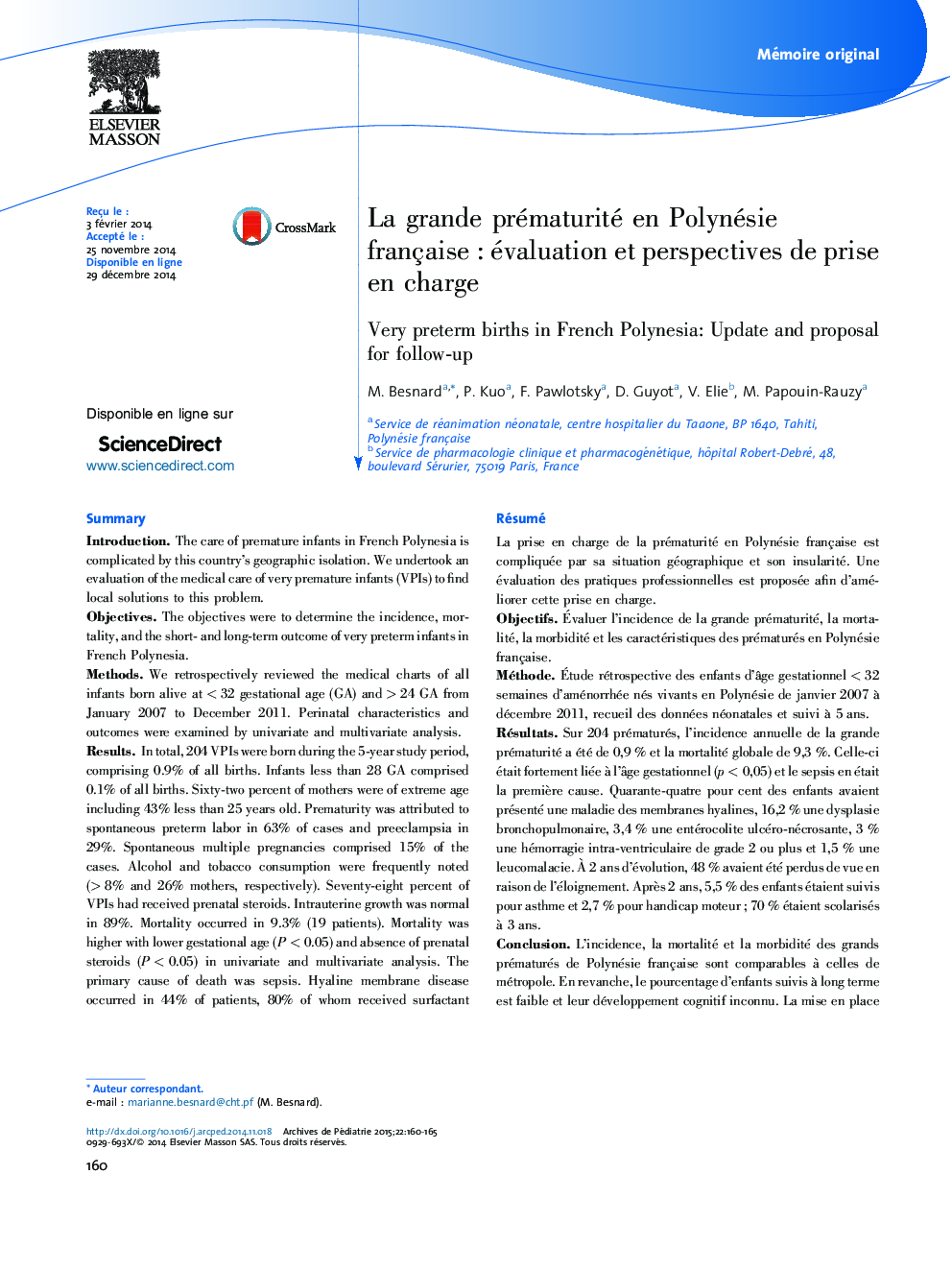| Article ID | Journal | Published Year | Pages | File Type |
|---|---|---|---|---|
| 4145988 | Archives de Pédiatrie | 2015 | 6 Pages |
RésuméLa prise en charge de la prématurité en Polynésie française est compliquée par sa situation géographique et son insularité. Une évaluation des pratiques professionnelles est proposée afin d’améliorer cette prise en charge.ObjectifsÉvaluer l’incidence de la grande prématurité, la mortalité, la morbidité et les caractéristiques des prématurés en Polynésie française.MéthodeÉtude rétrospective des enfants d’âge gestationnel < 32 semaines d’aménorrhée nés vivants en Polynésie de janvier 2007 à décembre 2011, recueil des données néonatales et suivi à 5 ans.RésultatsSur 204 prématurés, l’incidence annuelle de la grande prématurité a été de 0,9 % et la mortalité globale de 9,3 %. Celle-ci était fortement liée à l’âge gestationnel (p < 0,05) et le sepsis en était la première cause. Quarante-quatre pour cent des enfants avaient présenté une maladie des membranes hyalines, 16,2 % une dysplasie bronchopulmonaire, 3,4 % une entérocolite ulcéro-nécrosante, 3 % une hémorragie intra-ventriculaire de grade 2 ou plus et 1,5 % une leucomalacie. À 2 ans d’évolution, 48 % avaient été perdus de vue en raison de l’éloignement. Après 2 ans, 5,5 % des enfants étaient suivis pour asthme et 2,7 % pour handicap moteur ; 70 % étaient scolarisés à 3 ans.ConclusionL’incidence, la mortalité et la morbidité des grands prématurés de Polynésie française sont comparables à celles de métropole. En revanche, le pourcentage d’enfants suivis à long terme est faible et leur développement cognitif inconnu. La mise en place d’un réseau de suivi adapté aux conditions géographiques est proposée pour améliorer la prise en charge à long terme.
SummaryIntroductionThe care of premature infants in French Polynesia is complicated by this country's geographic isolation. We undertook an evaluation of the medical care of very premature infants (VPIs) to find local solutions to this problem.ObjectivesThe objectives were to determine the incidence, mortality, and the short- and long-term outcome of very preterm infants in French Polynesia.MethodsWe retrospectively reviewed the medical charts of all infants born alive at < 32 gestational age (GA) and > 24 GA from January 2007 to December 2011. Perinatal characteristics and outcomes were examined by univariate and multivariate analysis.ResultsIn total, 204 VPIs were born during the 5-year study period, comprising 0.9% of all births. Infants less than 28 GA comprised 0.1% of all births. Sixty-two percent of mothers were of extreme age including 43% less than 25 years old. Prematurity was attributed to spontaneous preterm labor in 63% of cases and preeclampsia in 29%. Spontaneous multiple pregnancies comprised 15% of the cases. Alcohol and tobacco consumption were frequently noted (> 8% and 26% mothers, respectively). Seventy-eight percent of VPIs had received prenatal steroids. Intrauterine growth was normal in 89%. Mortality occurred in 9.3% (19 patients). Mortality was higher with lower gestational age (P < 0.05) and absence of prenatal steroids (P < 0.05) in univariate and multivariate analysis. The primary cause of death was sepsis. Hyaline membrane disease occurred in 44% of patients, 80% of whom received surfactant therapy. In total, 16.2% newborns developed bronchodysplasia, 3.4% necrotizing enterocolitis, 3% cerebral hemorrhage, and 1.5% leukomalacia. Long-term outcome was marked by 52% of the patients lost to follow-up by 2 years of age, mostly because of geographic isolation. For the 72 patients followed-up, four developed asthma and three cerebral palsy; 70% were attending school by 3 years of age.ConclusionsThe incidence, mortality, and morbidity of very preterm birth in French Polynesia are comparable to reports from metropolitan centers in France. Conversely, nearly one-half of the patients were lost to follow-up, precluding meaningful information on intellectual development and other outcomes. We recommend organizing a long-term follow-up network to detect cognitive sequelae and adapting such a system to the geographical residence of French Polynesian families.
